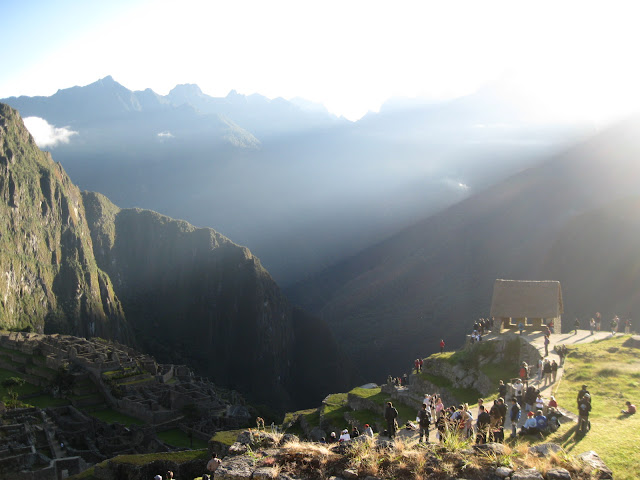
Ok so this is Machu Picchu. It is by far the place I was most excited to visit on this whole trip and it did not disappoint. It was a bit stressful getting there since our train to Aguas Calientes, the city at the base of Machu Picchu, was about three hours late picking us up. That gave us just enough time for about 2 hours of sleep in our hostel before waking up and getting ready get in line to catch the first bus up the mountain. We got in line at 5:00 and made it onto the second bus. The first one is at 5:30 and they're supposed to leave every 10 minutes, but our bus actually left right after the first one. I could try to explain what it's like to reach the top of the mountain and see this place, but I really just can't do it. It's indescribable. Someone we met here in La Paz explained it best I think. She said that because of all the hype surrounding Machu Picchu and all that you hear about it, you would think that when you get there it would be impossible for it to meet your expectations, but then it exceeds them. I feel like that's about the best way to attempt to describe Machu Picchu. The city and the surrounding mountains are more impressive than whatever you can picture in your head.

This right here is a trail that the Inca once used to get to Machu Picchu. It's not the famous Inca trail that you could follow 85 kilometers back to Cusco from here. This trail goes around the other side of Mount Machu Picchu, and today they call this the Inca bridge. I found a sign pointing to it and a guide said it was only 10 minutes out and 10 minutes to get back. We had plenty of time until the sun was to rise over the mountains so we checked it out. The views along this trail are ridiculous. Especially in the early morning when we were there, because then all the clouds are really low and the taller mountains off in the distance are orange on top because the sunlight is able to reach their peaks even though it hasn't risen yet where you're standing. Sadly, my camera was incapable of capturing all that color off in the distance, so here's a look back at the path before you reach the bridge.

It's called the Inca bridge because of that terrifying gap you can see there in the path. Today it's spanned by a few wooden planks, but there's no test of bravery here. The path is fenced off before you get to the bridge, so it's more a test of stupidity if you want to go for it. I've found that in South America, a place that's usually not too crazy about guard rails and extra safety precautions, if they went out of their way to stop you from going somewhere, you better not go there. What I'm wondering though is how the Inca got across, because that gap there looks intentionally built and symmetrical, and with so many Inca ruins still around and standing strong, I find it difficult to believe that their bridge collapsed and they needed the Peruvians to come in and fix it with some wooden planks.
This is the view looking out from up around the top of that first picture of the Inca bridge trail. It's a bummer you can't see the mountains in it.
I think this was taken from the same place just looking to the left now instead of out across the valley.
We made it back for the sunrise. It came up right over the top of this mountain and sent beams of light shooting to either side. Definitely the coolest sunrise I've seen. Sorry Isla del Sol.
This is how the light shone to the left of the mountain peak and onto the city.
After the sunrise we went back out by the buses to meet with our tour guide for the day. Here's a map of everything. You can enlarge it. It's got English and everything.
This is the gate to the city. The door is so tall because the emperor was always carried through it. They closed it at night to keep animals out like bears, foxes, and pumas, which are still sighted in the city occasionally.
This is the sun temple. It has two windows, one for the summer equinox and one for the winter equinox. (At least I believe it's equinox not solstice. I really don't know the difference. Kinda crazy considering how important they both were to every ancient civilization ever.) During each (equinox?) the sun rises so that its light shines perfectly through the window so that it can illuminate the entire stone altar you see there in the middle. We were there June 17, and this happens on June 21st. Almost saw it.
More terraces. Preventing landslides and providing farmland. Smart people.
I wanted to go into the common area, but you're not allowed to.
After our tour was over we thought we'd go climb a mountain. This is Huayna Picchu, or Wayna Picchu. Same thing. They let 400 people up here every day out of the 2,000 daily visitors to Machu Picchu. We were told that we were crazy if we didn't book a spot up there. It was definitely worth it.
There were sooooo many steps.
View of Machu Picchu from close to the top of Wayna Picchu.
I have tried to finish this post 3 times. I´ve had the internet die and erase my words twice now. Just enjoy the pictures. I´m not captioning them a third time because I actually wrote quite a bit from this point on and there´s other stuff I´d rather do right now.


















































